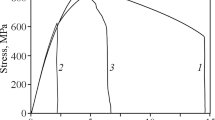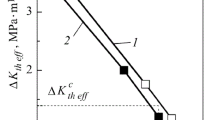Conclusions
The fractographic observations described here show convincingly that a weakening of the resistance to crack propagation due to the effect of water is associated with an increase of fracture brittleness in the microvolumes, which is observed with structural steels of different structures when various failure mechanisms are operative. If the IC mechanisms operate in crack propagation, then water has an increasing effect on ZECP, accompanied by a reduction in microplastic strain during failure along grain boundaries. If some other mechanisms are operative in crack propagation then the barrier band of increased resistance to fracture becomes narrower. In most cases the drawing zone and the pit zone, located near the starting areas of the fracture, act as this band. The coalescence of microcavities accompanied by the formation of low energy pits, becomes replaced here by a quasifracture mechanism which, in turn, becomes a transcrystalline cleavage. In high-tempered 50Kh steel the barrier pit zone is often replaced by direct intercrystalline cleavage.
Taking into account the quick action of the process of accelerating crack growth, this type of mutual replacement of fracture micromechanisms may be explained by the blocking of dislocations by chemisorbed hydrogen and by an obstruction to the process of condensation of vacancies into microcavities on the juvenile surface of the growing crack. Taking into account that the type of fracture microstructure in crack propagation is the same both under the action of water and with active hydrogenization, one can assume that the mechanisms of the effect of media are the same both in the first and second case. To assess the differences which can occur, above all during prolonged loading and at low K values, it is advisable to carry out an additional fractographic investigation into hydrogenation.
Similar content being viewed by others
Literature cited
E. A. Steigerwald, Proc. ASTM,60, 750 (1960).
W. A. van der Sluys, Trans. ASME, Ser.D,89, 28 (1967).
H. H. Johnson, in; Fracture, Vol. 3, Academic Press (1971), p. 679.
O. M. Romaniv, Yu. V. Zima, and G. V. Karpenko, Electronic Fractography of Hardened Steels [in Ukrainian], Naukova Dumka (1974).
O. N. Romaniv, G. N, Nikiforchin, and Yu. D. Petrina, Fiz.-Khim. Mekh. Mater., No. 1 (1974).
O. N. Romaniv, Yu. V. Zima, and Yu. D. Petrina, Fiz.-Khim. Mekh. Mater., No. 1 (1973).
O. N. Romaniv, Yu. D. Petrina, and Yu. V. Zima, Fiz.-Khim. Mekh. Mater., No. 4 (1973).
O. N. Romaniv, V. A. Dubin, and Yu. V. Zima, Fiz.-Khim. Mekh. Mater. No. l (1970).
O. N. Romaniv, Yu. V. Zima, and G. V. Karpenko, Dokl. Akad. Nauk SSSR,200, No. 3 (1971).
C. D. Beachem, Metallurg. Trans.,3, 437 (1972).
W. Brown and J. Srowly, in: Testing High-Strength Metallic Materials for Fracture Toughness with Plane Strain [Russian translation], Mir (1972).
O. N. Romaniv, N. L. Kuklyak, G. N. Nikiforchin, and I. A. Berezyuk, Fiz.-Khim. Mekh. Mater., No. 5 (1974).
Chin-Ichi Takamura, in: Physical Metal Science [Russian translation], No. 3, Mir (1968).
Author information
Authors and Affiliations
Additional information
Translated from Fiziko-Khimicheskaya Mekhanika Materialov, Vol. 11, No. 2, pp. 17–23, March–April, 1975.
Rights and permissions
About this article
Cite this article
Romaniv, O.N., Zima, Y.V., Nikiforchin, G.N. et al. Fractographic investigations of the easing of crack propagation in hardened steels by water. Mater Sci 11, 143–148 (1975). https://doi.org/10.1007/BF00716896
Received:
Issue Date:
DOI: https://doi.org/10.1007/BF00716896




